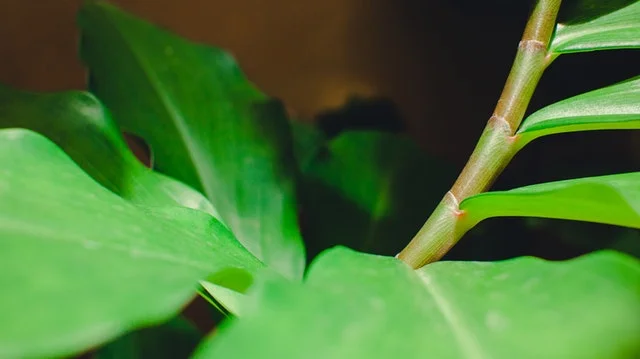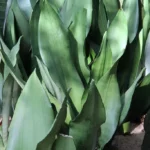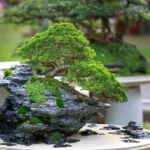The golden gate ficus is a bonsai tree. It has a lovely grey trunk with white stripes, earning it the nickname, Tiger Stripe Ficus, and produces a beautiful inverted flower.
Because of its tolerance of varying environments and easy, quick growth, it is a great option for beginners.
Table of Contents
How To Care For Golden Gate Ficus
This particular species is best cared for and grown inside due to its enjoyment of heat and humidity. However, in the summer, when the weather is warmer, it can be moved outside under the shade to enjoy the natural sunshine and humidity levels.
What does your golden gate ficus require?
Here is a look at what to provide the golden gate ficus to ensure it stays healthy for as long as possible.
- Light Requirements: The golden gate ficus can tolerate low lighting, but the trees love bright, indirect sunlight. They should not be exposed to direct sunlight in the afternoon as they can scorch. Prolonged exposure to low levels of light can cause the plant to be weak and disease-prone.
- Temperature Requirements: Ficus trees prefer warmer temperatures between 17-23 degrees Celsius (64-75 degrees Fahrenheit) during the day and between 13-16 degrees Celsius (57-61 degrees Fahrenheit) during the night. They should be kept away from drafts. They can survive temperatures as low as 10 degrees Celsius (50 degrees Fahrenheit, but they should not be exposed to it for any length of time. Keeping a consistent temperature is also recommended as too many variations cause leaf drop.
- Humidity Requirements: The best humidity levels are between 40-50%.
- Water Requirements: The ficus tree needs to be kept moderately wet. The soil should be checked each day. Watering is needed if the soil is dry to the touch. These plants can tolerate being underwatered, making them suitable for beginners. The water must not reach the bottom of the pot as it can cause root rot to develop. If this condition is difficult to maintain, it is often better to add less water to the soil while keeping the air humidity higher. Less moisture is required during the winter months.
- Soil Requirements: The best soils for bonsai trees consist of organic potting compost, lava rock, fine gravel, and pumice. The mixture should be pH neutral between 6.5 and 7.5.
- Fertilizer Requirements: The golden gate plant needs fertilizer every two weeks during growing seasons but should be decreased during the winter. Throughout the colder months, fertilizer is only required once a month.
Extra Tips For Golden Gate Ficus
Providing the basic care requirements for the plants is great for their natural growth and development.
At times, it can be handy to have some extra tips to ensure better performance and to treat pests and diseases that may arise.
Pests and Diseases
Dusting and inspecting the leaves for pests, disease, discoloration, and yellowing leaves, is highly recommended.
These actions can help to catch insects and illnesses before they overcome the plant. The following are the main issues that tend to cause problems for the golden gate ficus.
- Scale: The male scale insect appears similar to a gnat, while the female may appear to be a small bump on the leaf. These creatures leave behind a sticky substance on the leaves – often the first sign of their presence. Perhaps the next most common sign is the leaves turning yellow.
- Mealybugs: These small creatures are usually white or light pink. They settle into areas under leaves where they are less noticeable. One sign of these creatures other than seeing the insects is the white substance created by them.
- Spider Mites: The little black, white, or red spiders tend to leave wispy webs on the leaves that resemble a layer of dust. Upon inspection of the plant, it is often possible to see the spiders moving around.
- Root Rot: This appears as brown or black discolorating on the trunk close to the soil. The discoloration moves up the trunk as the disease worsens. Leaves may also turn yellow before turning brown or black.
Problems with insects and infestations may be prevented by spraying the plant with a mixture of soap and water.
While each pest may be unique in terms of appearance and the evidence they leave behind, they can all do damage to the stems and leaves.
Yellowed leaves and wilting stems are two of the most noticeable symptoms of infestations. Such issues can be treated using insecticides, insecticidal soap, or natural neem oil.
Root rot is typically treated by repotting the plant into fresh soil in a new pot. A fungicide is often required, but it is recommended to find something suitable specifically for the bonsai tree.
Pruning
These bonsai trees are very resilient in terms of pruning and even training. Pruning can be done to reduce the size of the tree or decrease the leaf size. The action can be taken once there are six to ten leaves produced.
At this point, two to four leaves may be removed. This level of trimming can be done at any time but performing it during the late summer or autumn months prevents potential scarring.
Total defoliation may be completed also. This procedure should be done at the end of spring, but only on healthy plants.
This process can help new growth to occur. Because cutting the stems and leaves can cause the foliage to release a milky latex, defoliation can be a messy process. This latex substance will gradually dry and form a seal over the cuts.
Pruning may be done to train the tree to grow into particular shapes. Caregivers may want to perform this when the branches are no more than half an inch thick as they are easier to cut at this size. Any cuts made should be smooth and concave.
Sterilized shears or sharp scissors may be used for these procedures. Shoots should be left to the length where three or four nodes remain intact.
Propagation
Propagating these bonsai trees is typically done through cuttings. The cuttings should be taken from healthy branches and dipped in rooting powder. It may then be placed in a four-inch pot filled with river sand.
Roots typically develop within a month. Once roots are produced, the cutting should be gently removed from the pot, the leaves (except those at the top) removed, and the stem repotted into the same soil.
Propagation works best when the pot is placed in the shade with a seaweed fertilizer added. After three months, sufficient roots should have developed for it to be planted.
Toxicity
This species of bonsai tree is poisonous to animals.
Photo by Nothing Ahead from Pexels



